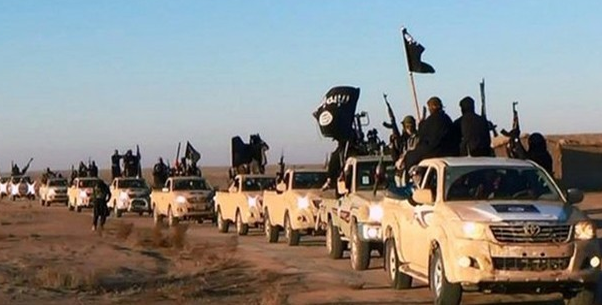[ by Charles Cameron — the one point missing IMO in an otherwise fine piece ]
.
**
In WaPo, under the header How the violent Islamic State extremists got their signature flag, Abby Phillip tackles what I believe is a very significant question, that of the black banners, but doesn’t mention their “end times” significance:
Since the Islamic State began consolidating territory in its bloody campaign over the last year or so, it has gone from relative obscurity to global notoriety — and so has its flag.
The black-and-white banner is not only being flown in Iraq and Syria, where the group has claimed a “caliphate,” but also in London — and now, apparently, New Jersey and outside the White House.
Mark Dunaway — a Garwood, N.J., resident who converted to Islam about 10 years ago — seemed to have no idea that the flag he was hanging outside his house was associated with a violent militant group that’s on the march in the Syria in Iraq.
“I hang it every Friday and every Ramadan which ended not too long ago and I keep it up a little longer than I normally do,” Dunaway told FoxNews.com. “I guess some people saw it and got offended so I took it down. I do not support any militant group or anything like that.”
Dunaway removed the flag from the front of his house, replacing it with one for an American football team, the San Diego Chargers, according to NJ.com.
“I understand now that people turn on CNN and see the flag associated with jihad, but that’s not the intention of that flag at all,” Dunaway told NJ.com. “It says ‘There is only one god, Allah, and the prophet Muhammad is his messenger.’ It’s not meant to be a symbol of hate. Islam is all about unity and peace. I am not a part of any group like that, and I’m not anti-American. I love my country, but I am a Muslim.”
Dunway did not respond to requests for comment on Thursday and Friday.
Putting aside the question of whether he had ever heard of the Islamic State or seen the flag flown in photos accompanying dozens of media reports in recent years, the real history of the flag is fairly recent and inextricably linked to jihad.
So how does an unsuspecting New Jersey man end up with a flag associated with a brutally violent militant group? Well, for one thing, you can buy the Islamic State’s flag on eBay for a mere $20, as of this writing.
[ .. more .. ]
That’s all okay, that’s interesting. But there’s one salient aspect of the “black banner” story that’s missing from Ms. Phillip’s account — the hadith which claims that an army with black banners will sweep victoriously from Khorasan (roughly, Afghanistan / Iran) to Jerusalem in the Islamic equivalent of the Christian “end times” war culminating in the battle of Armageddon.
The important thing here is that the black flag signals belief that the army and war in question are those associated with the Mahdi, Islam’s end times awaited eschatological figure.
**
It’s very easy for us to overlook the Mahdist / end times aspect of IS and other jihadist rhetoric, because we tend to dismiss end times belief as somehow quaint and outdated. I’ve been suggesting it’s more like an undertow that may catch us unawares if we don’t pay attention.
I’ve written quite a bit about this myself [eg 1, 2, 3, 4, 5, 6, 7 — see also Aaron Zelin‘s On flags, Islamic History and Al-Qaida.]
The meaning attaching to symbols morphs over time, sure, and the “black banners” hadith may or may not be the “central” meaning of the flag with shahada and seal, now strongly and almost exclusively associated with the IS attempt at a caliphate — but the IS magazine Dabiq in its first two issues (1, 2) makes that end times connection pretty clear, even if the flag itself doesn’t.
This kind of end times appeal is always something to be particularly watchful of.



